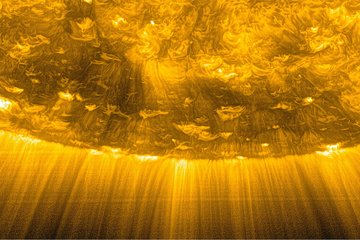All genres
1.
Journal Article
Does Turbulence along the Coronal Current Sheet Drive Ion Cyclotron Waves? The Astrophysical Journal 944, p. 227 (2023)
2.
Journal Article
Linking Small-scale Solar Wind Properties with Large-scale Coronal Source Regions through Joint Parker Solar Probe-Metis/Solar Orbiter Observations. The Astrophysical Journal 935, p. 112 (2022)
3.
Journal Article
Kinetic cascade beyond magnetohydrodynamics of solar wind turbulence in two-dimensional hybrid simulations. Physics of Plasmas 19, 022305 (2012)
4.
Journal Article
Parametric decay of oblique Alfvén waves in two-dimensional hybrid simulations. Physical Review E 86, 027401 (2012)
5.
Journal Article
On nonlinear Alfven-cyclotron waves in multi-species plasma. Journal of Plasma Physics 77, pp. 385 - 403 (2011)
6.
Journal Article
Schwach kompressive, hochfrequente Wellen im inhomogenen Multifluid-Plasma. Mitteilungen der Deutschen Geophysikalischen Gesellschaft e.V. 3, pp. 5 - 9 (2011)
7.
Journal Article
Compressive high-frequency waves riding on an Alfvén/ion-cyclotron wave in a multi-fluid plasma. Journal of Plasma Physics 77, pp. 693 - 707 (2011)
8.
Journal Article
Apparent temperature anisotropies due to wave activity in the solar wind. Annales Geophysicae 29, pp. 909 - 917 (2011)
9.
Journal Article
Injection to the pick-up ion regime from high energies and induced ion power-laws. Astronomy and Astrophysics 505, pp. 329 - 337 (2009)
10.
Journal Article
Spectral intensities of Anomalous Cosmic Rays derived from the injection rate at the solar wind termination shock. Astrophysics and Space Sciences Transactions 5, pp. 21 - 30 (2009)
11.
Journal Article
Solar wind proton reflection and injection to the ACR regime at the parallel termination shock. Astrophysics and Space Sciences Transactions 5, pp. 15 - 19 (2009)
12.
Thesis - PhD
On convected wave structures and spectral transfer in space plasmas - applications to solar corona and solar wind. Dissertation, Technische Universität Braunschweig (2012)










